Business
'Who's going to live here?' What happens when an e-commerce warehouse takes out your neighborhood
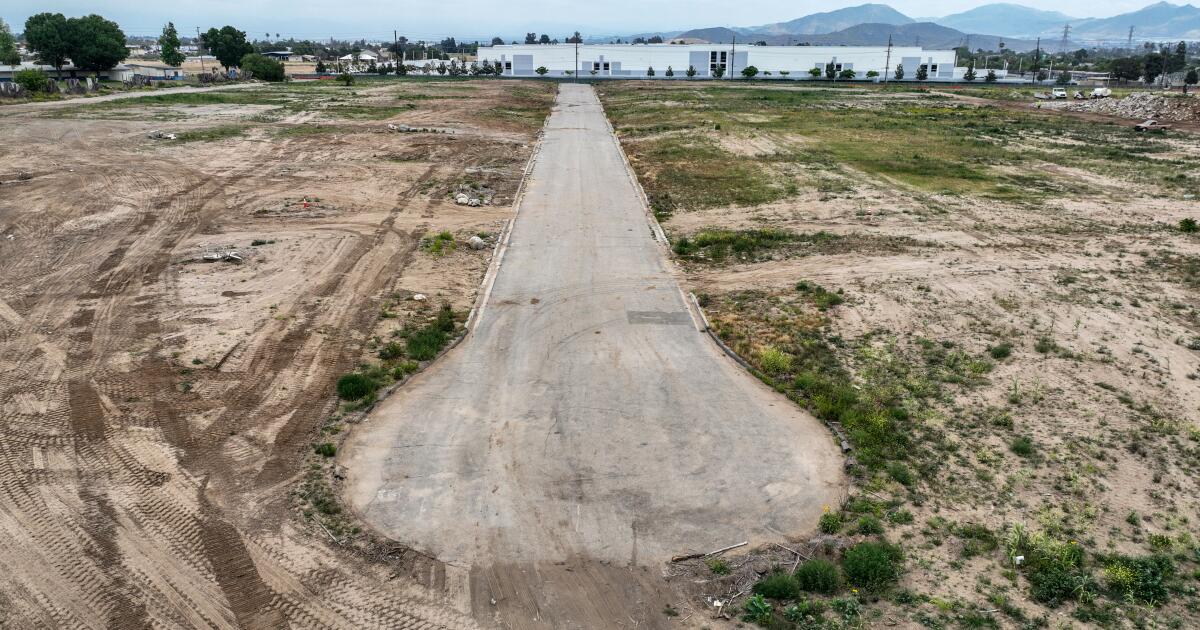
Benjamin and Christine Granillo bought their 2.25-acre property in San Bernardino County four decades ago. They built their home by hand and surrounded it with a lush grove of avocado, orange and lemon trees.
“We thought we’d be here for the rest of our life,” Christine Granillo, 77, said as she tended to her trees on a recent afternoon.
But their neighborhood in unincorporated Bloomington is rapidly transforming, as developers convert the 10 Freeway and its adjacent communities into a logistics corridor connecting goods shipped into Southern California ports with online shoppers across the nation. An industrial real estate company based in Orange County is demolishing 117 homes and ranches in rural Bloomington to make way for more than two million square feet of warehousing space. The project will serve as yet another distribution center dedicated to storing and moving the vast array of products consumers want delivered to their doorsteps.
Benjamin and Christine Granillo, who built their home by hand in rural Bloomington, will soon look out on a sprawling online fulfillment center.
(Robert Gauthier / Los Angeles Times)
All the neighbors across the street from the Granillos sold their homes to the developer, and many have already been bulldozed. The Granillos opted not to sell — and now look out their stately front gate at the rubble, soon to be supplanted with a 479,000-square-foot fulfillment center. Their street will become a busy truck route. Next door will be a parking lot with hundreds of truck and trailer stalls.
Christine Granillo mourns the loss of her neighbors and her view of the San Bernardino Mountains. But, she added, “What can you do about it? There’s really nothing you can do about it.”
In November 2022, San Bernardino County supervisors voted 4-0 to approve the Bloomington Business Park, a 213-acre industrial park that promises to bring several thousand jobs to Bloomington, a majority Latino community of 23,000 residents.
The deal came with trade-offs familiar to the Inland Empire communities being asked to shoulder the massive distribution centers integral to America’s online shopping habit: An environmental impact report found the development would have “significant and unavoidable” impacts on air quality. But it would bring jobs to a working-class community in need of them, and Howard Industrial Partners has pledged to provide millions of dollars in infrastructure improvements: new streets with traffic lights and sidewalks; a modern sewer system in an area that still relies on aging septic systems.
And because the warehouse project would be about 50 feet from Zimmerman Elementary School, the developer agreed to pay $44.5 million to the Colton Joint Unified School District in a land swap that will usher in a state-of-the-art school nearby.
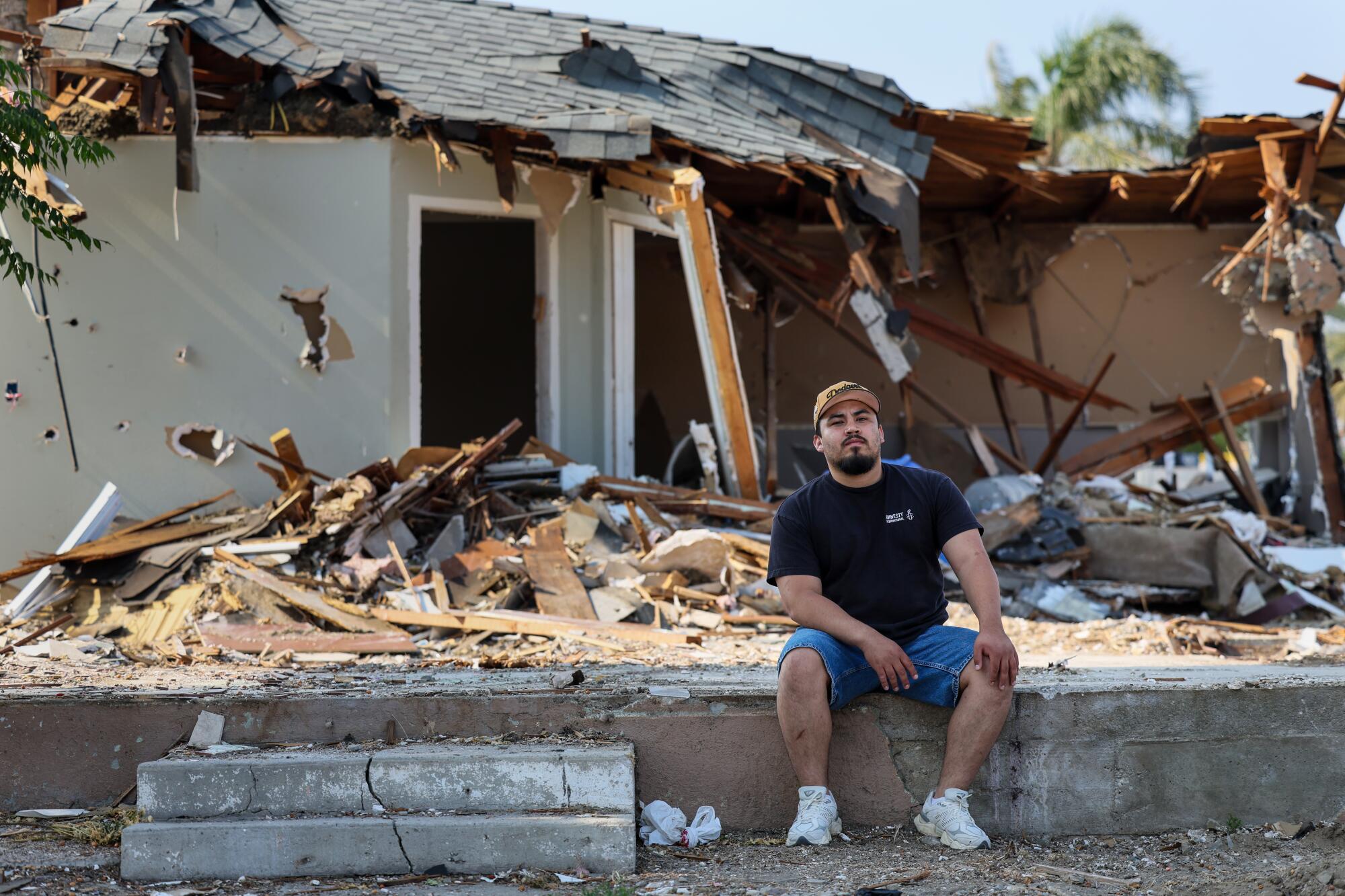
Joaquin Castillejos advocates for Bloomington residents whose neighborhoods are targeted for warehouse projects. But he said people are experiencing the impact of years of poor planning.
(Robert Gauthier / Los Angeles Times)
Gary Grossich, a member of Bloomington’s Municipal Advisory Council, recommended that supervisors support the development. Surrounding cities like Rialto and Fontana are embracing warehouse development, he said, and this was an opportunity for Bloomington to reap the benefits of a booming industry.
“The warehouse industry was the hot market,” he said, “and that was the only way that myself and others could see that we were going to get to the greater good, which is to get more sheriff’s deputies, more public safety, more services for our community and eventually balance our books.”
Mike Tunney, vice president of development at Howard Industrial Partners, said the developer shares those goals. “Overcoming these types of challenges and opportunities are the fundamental tenets of our development philosophy,” Tunney said.
But the project has left Bloomington fractured, with a stinging sense of winners and losers: Many who sold their homes say they got a good price and were happy to move on, while many of the neighbors left behind see a future with more concrete and semi-trailers and a hollowing out of the community’s rural culture.

Esmeralda Tabares, left, calls the conversion of rural neighborhoods to industrial developments “just a complete shift in the culture and lifestyle” of Bloomington.
(Robert Gauthier / Los Angeles Times)
Esmeralda Tabares, 23, part of a group called Concerned Neighbors of Bloomington, described the transition from rural residential to industrial development as “just a complete shift in the culture and lifestyle we have.” Many Bloomington residents ride horses; her family owns a plant nursery.
She questions why San Bernardino County is relying on a developer to provide the community with critical infrastructure such as sidewalks and sewers.
“It’s just easier for them to shift to a warehouse and say, ‘Well, we’re going to let them come in and take over your community,’” she said. “But now what community is that going to be? Because they’re taking people out, and soon who’s going to go to the school? Who’s going to live here?”
Agents associated with Howard Industrial Partners approached Raquel Diaz several years ago about selling her home in a Bloomington neighborhood a mile south of the 10 Freeway with an offer that wouldn’t go through until the county approved the project.
She and her family had purchased their home in 2012 for $140,000. It was the first home for her family of five, she said, and they were “super excited.” But the three-bedroom house on Locust Avenue quickly became a nightmare.
The house flooded whenever it rained. It reeked of moisture, and she and her husband worried about raising young kids amid mold.
Their street had no sidewalks, but that didn’t stop people from speeding by in their cars. Accidents were alarmingly common, she said. Her kids were forbidden from checking the street-side mailbox or taking out the trash.
“We ended up with a lemon of a house,” she said. “We were happy to be in Bloomington, and it just didn’t end up working out for us.”
By the time the county approved the warehouse development, home prices across Southern California had skyrocketed. Diaz said the developer encouraged them to find a home they wanted to buy — even if it cost above the price they had originally negotiated — and to make sure it was on a hill. The company would cover the cost.
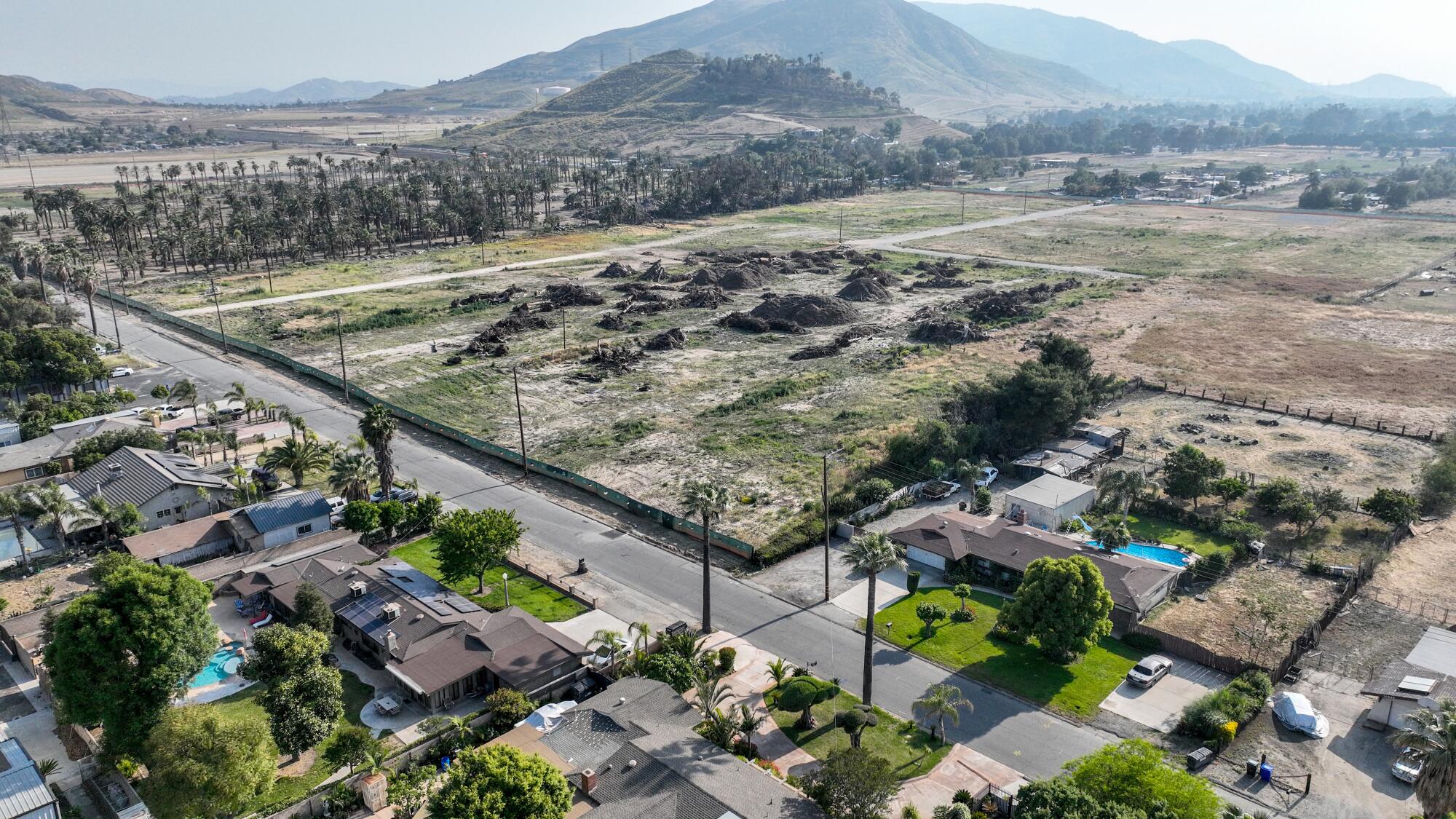
Unincorporated Bloomington is transforming, as developers look to raze neighborhoods near the 10 Freeway to create a logistics corridor dedicated to online shopping needs.
(Robert Gauthier / Los Angeles Times)
They selected a five-bedroom, five-bathroom home in Highland, a nearby suburb at the base of the San Bernardino Mountains, and closed on the property in January 2023 for $1.05 million. The 3,800-square-foot home has a pool and views. It’s on a sewer system, and while their residential street doesn’t have sidewalks, the nearby roads have sidewalks and bike lanes.
“It still feels unreal where we ended up,” she said. “It’s beautiful. I completely love where I live.”
Diaz has heard other residents say that homeowners were harassed and pressured to sell. She is adamant that’s not the case.
“No one is forcing me out,” she said. “It was a blessing to get the opportunity to be able to have a new start.”
Carolina Rios also saw the developer’s offer as an opportunity.
Rios and her family paid $225,000 for their Bloomington home and lived there about 13 years. She has fond memories of the three-bedroom house on Laurel Avenue: She threw her daughter’s quinceañera there, and she and her husband were married in the yard.
But the house was old, and instead of storm drains, the homes on her street had pipes under the driveways that flowed into ditches. The street flooded every time it rained. They had to walk atop pallets and bricks to cross the yard.
“Across the street, their ditch was 24/7, 365 days a year full of water and mosquitoes and raccoons and snakes and all sorts of fun wildlife to go to the zoo and look at,” she said. “But not in my house, around my kids.”
She agreed to sell in 2016; she said the developer adjusted the purchase price in 2023 — to $1.4 million — after the county approved the project, in recognition of rising home prices. In late December, she closed on a new house in Riverside with an extra bedroom, a swimming pool and an enclosed patio. She paid $1.2 million in cash.
She knows some people are opposed to warehouse development, but she says the industry is bringing good jobs. Her oldest children, ages 27 and 24, both work at a FedEx warehouse in Bloomington, where they have flexible hours and get frequent raises, she said.
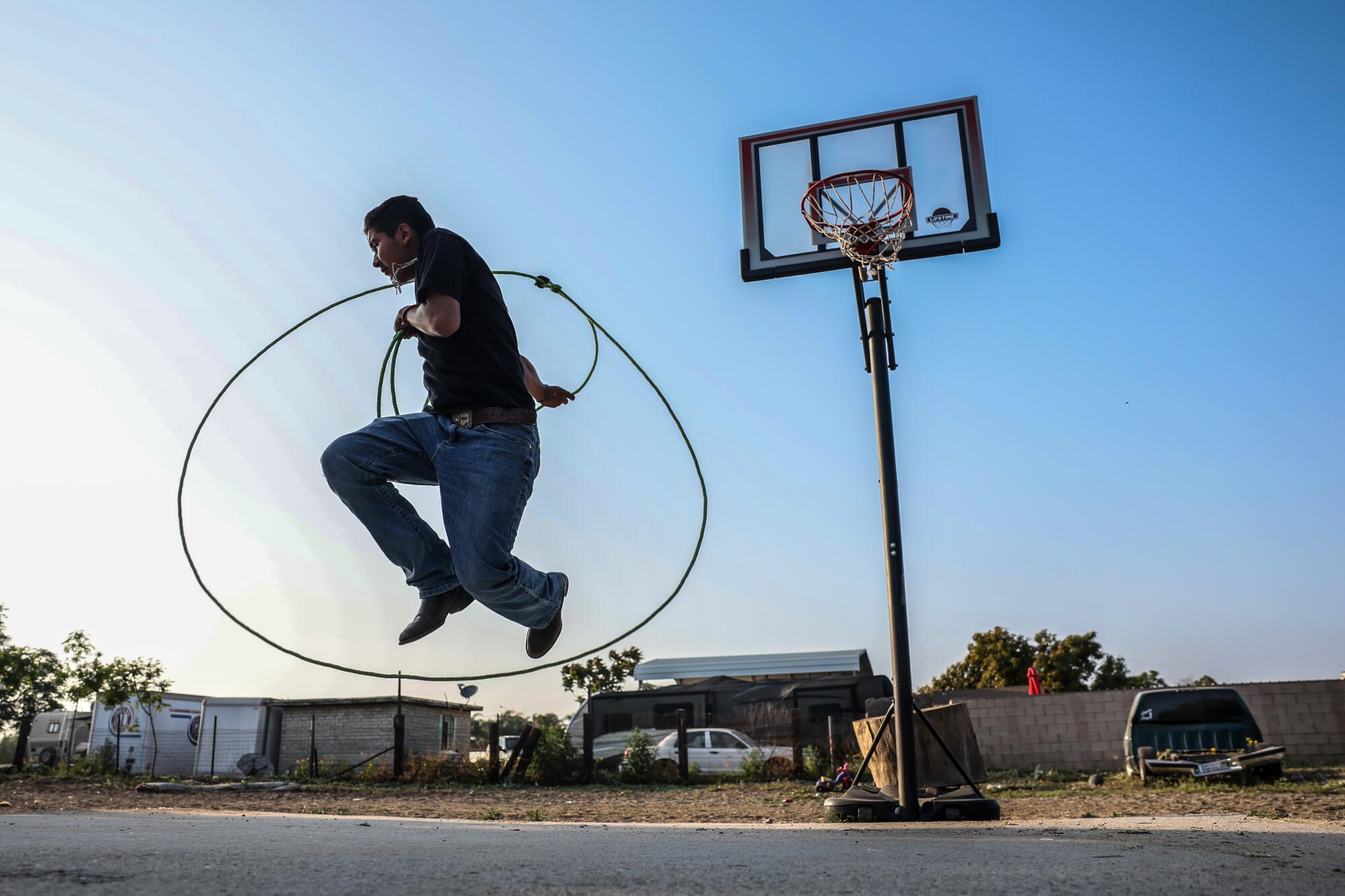
Jessie Ortiz practices roping skills in the backyard of his family’s Bloomington home.
(Robert Gauthier / Los Angeles Times)
While some homeowners seized on the opportunity to move out of Bloomington, Felipe and Blanca Ortiz felt blindsided when their landlord sold the ranch home they were renting to the developer.
The Ortizes and their four children have lived on the two-acre property for more than a decade. They’ve maintained their family traditions from the Mexican state of Morelos, raising horses, goats and chickens on their small property.
They loved riding their horses through the hills behind their home, and regularly traveled to other cities to ride their horses in parades, decked out in traditional Mexican cowboy and cowgirl attire. They organized 100-horse processions as fundraisers for neighbors in need.
“It’s their entire lives,” Felipe Ortiz said, as he shared TikTok videos of his kids performing on horseback.
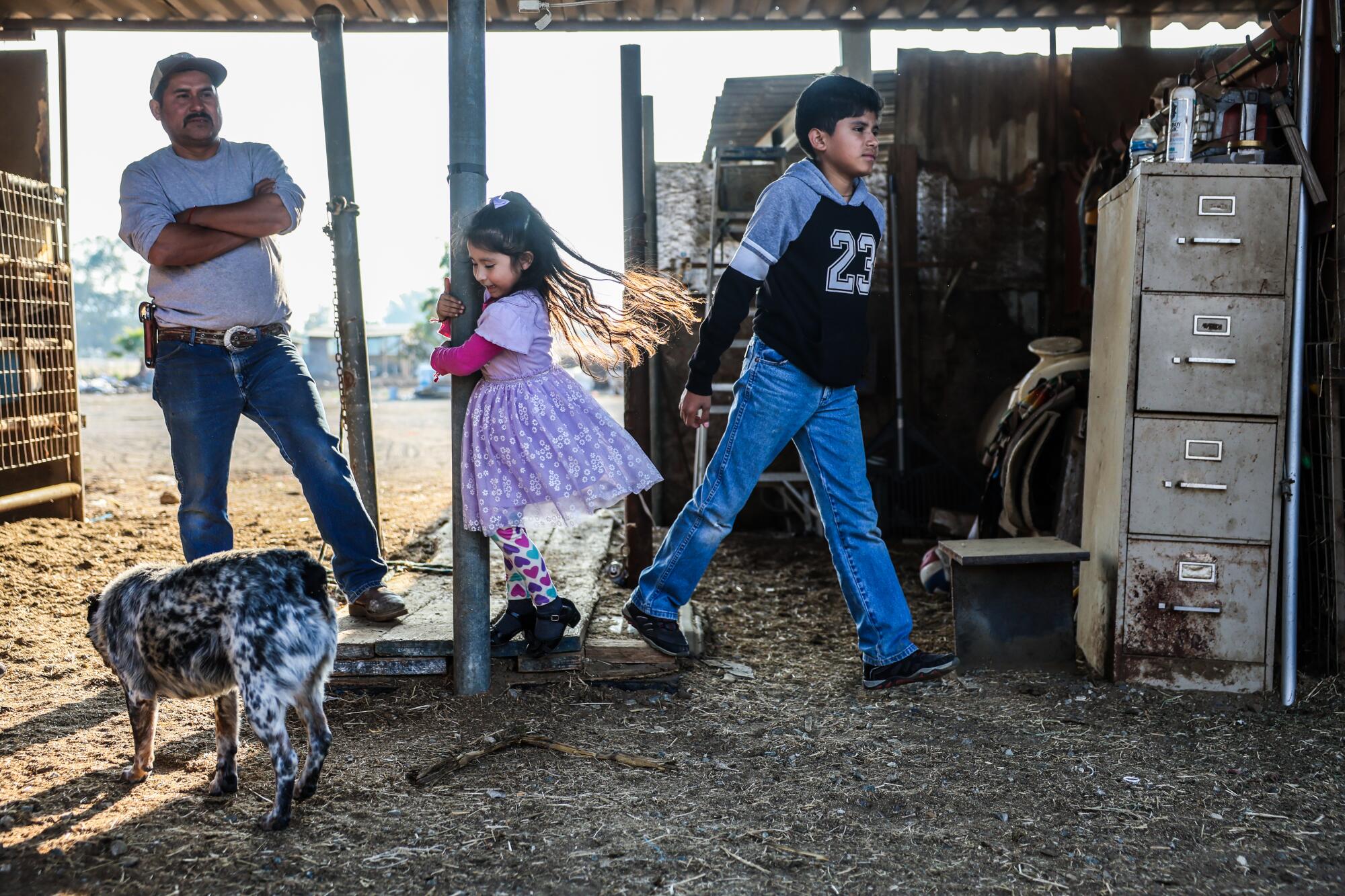
Felipe Ortiz and his family are being evicted from the ranch home they have rented for more than a decade.
(Robert Gauthier / Los Angeles Times)
In February, the family got a notice informing them their rental agreement would end in 60 days. It came from a company connected to Timothy Howard of Howard Industrial Partners — the only indication the family had that their rental home had been sold.
That same day, footage from the Ortiz family’s security camera shows an excavator knocking down the chain link gate in front of the ranch. The two youngest Ortiz kids, ages 6 and 12, were home at the time. The family viewed it as an act of intimidation.
Tunney, with Howard Industrial Partners, said it was “regrettable” that the previous owner didn’t disclose the sale to the Ortiz family.
“Additionally, it was not disclosed to us that there were occupants on the property,” Tunney said. “The incident with the excavator was inadvertent as the operator was scheduled to work at a nearby site and confused the addresses.”
Several months later, the family is still living in the home, waiting out the eviction process. Ortiz says he is struggling to find another property that will accommodate the family of six and their eight horses. As their search wears on, he said, his kids are traumatized. His youngest returns from school each day wondering if their home has been knocked down.
“Every day, the machines pass by here to knock down homes behind us,” Ortiz said. “And you’re left with the fear that they are coming to knock down our house.”
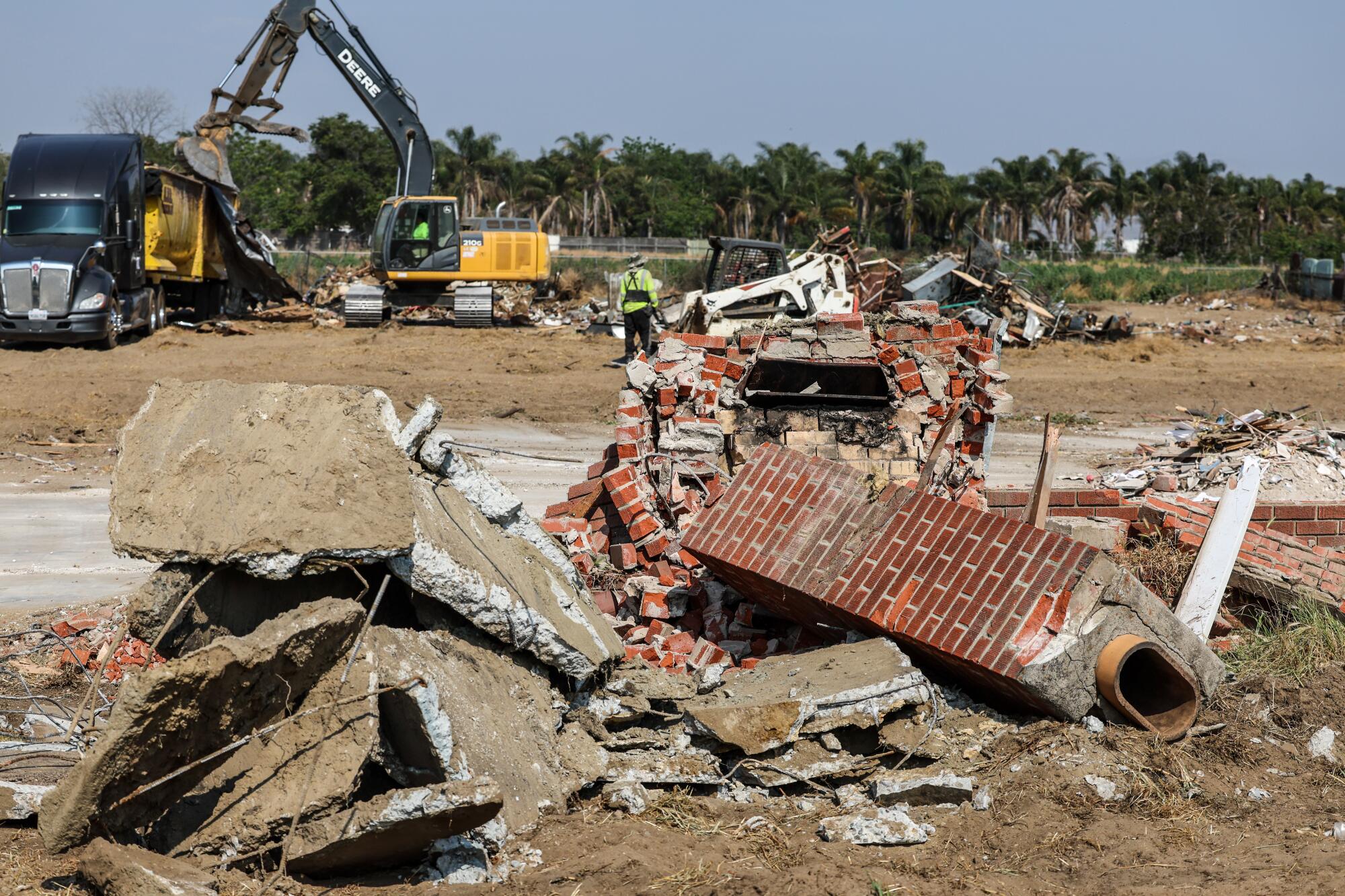
As homes are demolished in rural Bloomington to make way for a warehousing project, the neighbors who remain look out at rubble.
(Robert Gauthier / Los Angeles Times)
As the demolitions proceed, a coalition of environmental groups has sued San Bernardino County and Howard Industrial Partners, trying to halt the project. The lawsuit, alleging violations of state environmental and fair housing laws, seeks to vacate the county’s approval and require a more “meaningful” review.
Adrian Martinez is deputy managing attorney for Earthjustice, the group representing the defendants. He called their effort a key moment in “the fight against the freight industry and its disregard for public health.”
“There are people who don’t want these warehouses in their communities and they just want to be left with peace,” Martinez said. “I think the inflection point is this kind of misguided notion that to give a community resources, you have to stuff thousands of trucks in the community and air pollution. And there’s no place in the country that this story is more robust than the Inland Empire and Bloomington in particular.”
A hearing is scheduled for later this month in San Bernardino County Superior Court.
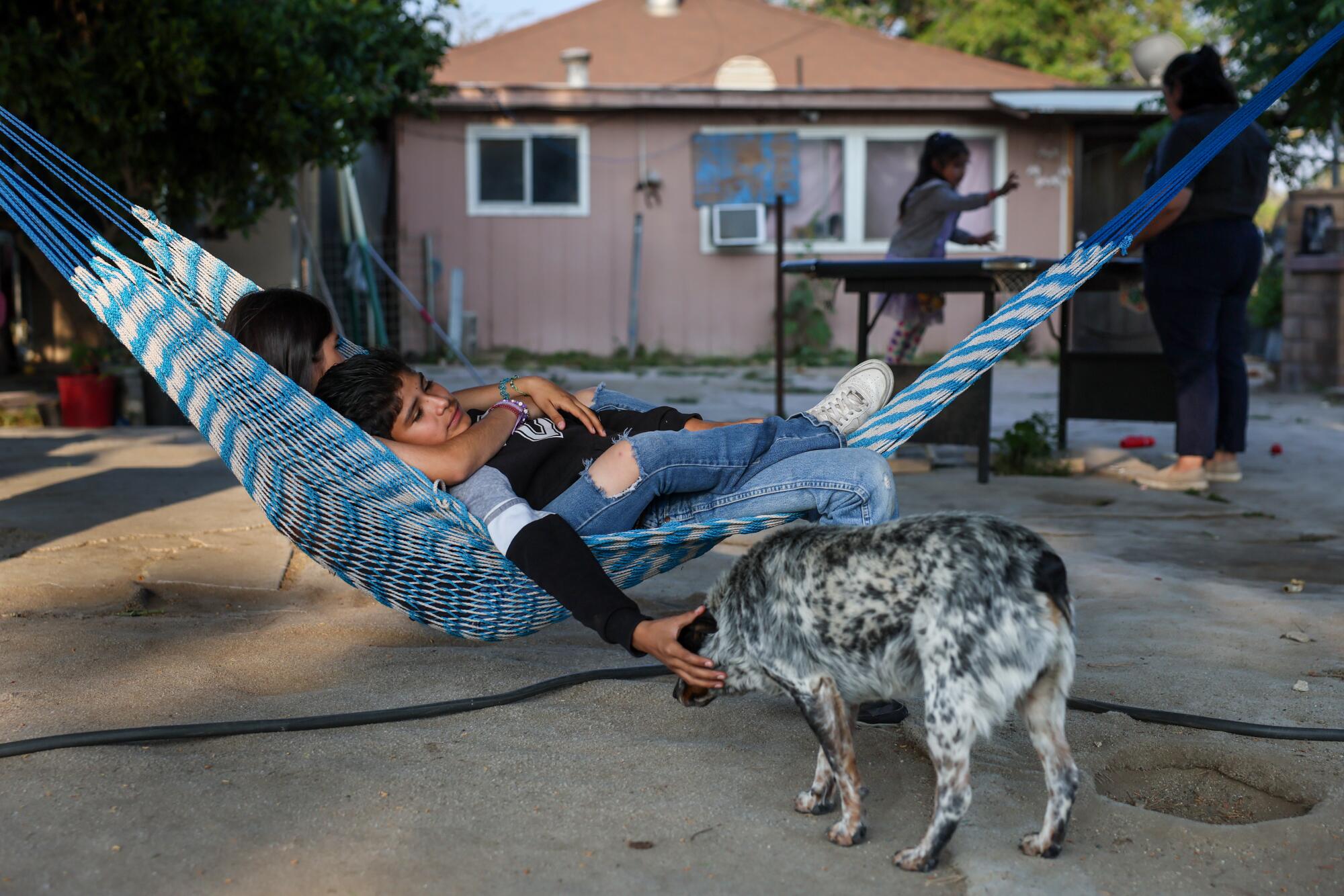
“Everyday, the machines pass by here to knock down homes behind us,” Felipe Ortiz says of his family’s plight. “And you’re left with the fear that they are coming to knock down our house.”
(Robert Gauthier / Los Angeles Times)
Meanwhile, just a couple miles away, residents in southeastern Bloomington are starting to hear from developers interested in building more warehouses in the area.
Daniela Vargas, 24, said her parents bought their house there more than two decades ago. For her parents, both Mexican immigrants, it’s a deep source of pride to own a home they could pass down to their four children.
Vargas’ family raises chickens on their land, but the surrounding area is pockmarked with industry. Just a short drive from the family’s home is another warehouse complex, a railroad and the 10 Freeway.
Recently, they’ve received phone calls and “strange-looking mail” from developers interested in buying their home, Vargas said: “It looks like a check that says, ‘Here’s X amount of money, call us to make it real.’”
She said her family doesn’t want to leave, but it feels inevitable that their neighborhood will be the next to transform.
“Anyone that moves out of Bloomington, it’s all valid reasoning,” Vargas said. “My family is really prideful. But if the decision comes that warehouses are going to be developed here and everybody is leaving, we can’t remain with so much pollution around us, with so much traffic and with no real neighbors or neighborhood amenities.”
This article is part of The Times’ equity reporting initiative, funded by the James Irvine Foundation, exploring the challenges facing low-income workers and the efforts being made to address California’s economic divide.

Business
U.S. Space Force awards $1.6 billion in contracts to South Bay satellite builders

The U.S. Space Force announced Friday it has awarded satellite contracts with a combined value of about $1.6 billion to Rocket Lab in Long Beach and to the Redondo Beach Space Park campus of Northrop Grumman.
The contracts by the Space Development Agency will fund the construction by each company of 18 satellites for a network in development that will provide warning of advanced threats such as hypersonic missiles.
Northrop Grumman has been awarded contracts for prior phases of the Proliferated Warfighter Space Architecture, a planned network of missile defense and communications satellites in low Earth orbit.
The contract announced Friday is valued at $764 million, and the company is now set to deliver a total of 150 satellites for the network.
The $805-million contract awarded to Rocket Lab is its largest to date. It had previously been awarded a $515 million contract to deliver 18 communications satellites for the network.
Founded in 2006 in New Zealand, the company builds satellites and provides small-satellite launch services for commercial and government customers with its Electron rocket. It moved to Long Beach in 2020 from Huntington Beach and is developing a larger rocket.
“This is more than just a contract. It’s a resounding affirmation of our evolution from simply a trusted launch provider to a leading vertically integrated space prime contractor,” said Rocket Labs founder and chief executive Peter Beck in online remarks.
The company said it could eventually earn up to $1 billion due to the contract by supplying components to other builders of the satellite network.
Also awarded contracts announced Friday were a Lockheed Martin group in Sunnyvalle, Calif., and L3Harris Technologies of Fort Wayne, Ind. Those contracts for 36 satellites were valued at nearly $2 billion.
Gurpartap “GP” Sandhoo, acting director of the Space Development Agency, said the contracts awarded “will achieve near-continuous global coverage for missile warning and tracking” in addition to other capabilities.
Northrop Grumman said the missiles are being built to respond to the rise of hypersonic missiles, which maneuver in flight and require infrared tracking and speedy data transmission to protect U.S. troops.
Beck said that the contracts reflects Rocket Labs growth into an “industry disruptor” and growing space prime contractor.
Business
California-based company recalls thousands of cases of salad dressing over ‘foreign objects’

A California food manufacturer is recalling thousands of cases of salad dressing distributed to major retailers over potential contamination from “foreign objects.”
The company, Irvine-based Ventura Foods, recalled 3,556 cases of the dressing that could be contaminated by “black plastic planting material” in the granulated onion used, according to an alert issued by the U.S. Food and Drug Administration.
Ventura Foods voluntarily initiated the recall of the product, which was sold at Costco, Publix and several other retailers across 27 states, according to the FDA.
None of the 42 locations where the product was sold were in California.
Ventura Foods said it issued the recall after one of its ingredient suppliers recalled a batch of onion granules that the company had used n some of its dressings.
“Upon receiving notice of the supplier’s recall, we acted with urgency to remove all potentially impacted product from the marketplace. This includes urging our customers, their distributors and retailers to review their inventory, segregate and stop the further sale and distribution of any products subject to the recall,” said company spokesperson Eniko Bolivar-Murphy in an emailed statement. “The safety of our products is and will always be our top priority.”
The FDA issued its initial recall alert in early November. Costco also alerted customers at that time, noting that customers could return the products to stores for a full refund. The affected products had sell-by dates between Oct. 17 and Nov. 9.
The company recalled the following types of salad dressing:
- Creamy Poblano Avocado Ranch Dressing and Dip
- Ventura Caesar Dressing
- Pepper Mill Regal Caesar Dressing
- Pepper Mill Creamy Caesar Dressing
- Caesar Dressing served at Costco Service Deli
- Caesar Dressing served at Costco Food Court
- Hidden Valley, Buttermilk Ranch
Business
They graduated from Stanford. Due to AI, they can’t find a job

A Stanford software engineering degree used to be a golden ticket. Artificial intelligence has devalued it to bronze, recent graduates say.
The elite students are shocked by the lack of job offers as they finish studies at what is often ranked as the top university in America.
When they were freshmen, ChatGPT hadn’t yet been released upon the world. Today, AI can code better than most humans.
Top tech companies just don’t need as many fresh graduates.
“Stanford computer science graduates are struggling to find entry-level jobs” with the most prominent tech brands, said Jan Liphardt, associate professor of bioengineering at Stanford University. “I think that’s crazy.”
While the rapidly advancing coding capabilities of generative AI have made experienced engineers more productive, they have also hobbled the job prospects of early-career software engineers.
Stanford students describe a suddenly skewed job market, where just a small slice of graduates — those considered “cracked engineers” who already have thick resumes building products and doing research — are getting the few good jobs, leaving everyone else to fight for scraps.
“There’s definitely a very dreary mood on campus,” said a recent computer science graduate who asked not to be named so they could speak freely. “People [who are] job hunting are very stressed out, and it’s very hard for them to actually secure jobs.”
The shake-up is being felt across California colleges, including UC Berkeley, USC and others. The job search has been even tougher for those with less prestigious degrees.
Eylul Akgul graduated last year with a degree in computer science from Loyola Marymount University. She wasn’t getting offers, so she went home to Turkey and got some experience at a startup. In May, she returned to the U.S., and still, she was “ghosted” by hundreds of employers.
“The industry for programmers is getting very oversaturated,” Akgul said.
The engineers’ most significant competitor is getting stronger by the day. When ChatGPT launched in 2022, it could only code for 30 seconds at a time. Today’s AI agents can code for hours, and do basic programming faster with fewer mistakes.
Data suggests that even though AI startups like OpenAI and Anthropic are hiring many people, it is not offsetting the decline in hiring elsewhere. Employment for specific groups, such as early-career software developers between the ages of 22 and 25 has declined by nearly 20% from its peak in late 2022, according to a Stanford study.
It wasn’t just software engineers, but also customer service and accounting jobs that were highly exposed to competition from AI. The Stanford study estimated that entry-level hiring for AI-exposed jobs declined 13% relative to less-exposed jobs such as nursing.
In the Los Angeles region, another study estimated that close to 200,000 jobs are exposed. Around 40% of tasks done by call center workers, editors and personal finance experts could be automated and done by AI, according to an AI Exposure Index curated by resume builder MyPerfectResume.
Many tech startups and titans have not been shy about broadcasting that they are cutting back on hiring plans as AI allows them to do more programming with fewer people.
Anthropic Chief Executive Dario Amodei said that 70% to 90% of the code for some products at his company is written by his company’s AI, called Claude. In May, he predicted that AI’s capabilities will increase until close to 50% of all entry-level white-collar jobs might be wiped out in five years.
A common sentiment from hiring managers is that where they previously needed ten engineers, they now only need “two skilled engineers and one of these LLM-based agents,” which can be just as productive, said Nenad Medvidović, a computer science professor at the University of Southern California.
“We don’t need the junior developers anymore,” said Amr Awadallah, CEO of Vectara, a Palo Alto-based AI startup. “The AI now can code better than the average junior developer that comes out of the best schools out there.”
To be sure, AI is still a long way from causing the extinction of software engineers. As AI handles structured, repetitive tasks, human engineers’ jobs are shifting toward oversight.
Today’s AIs are powerful but “jagged,” meaning they can excel at certain math problems yet still fail basic logic tests and aren’t consistent. One study found that AI tools made experienced developers 19% slower at work, as they spent more time reviewing code and fixing errors.
Students should focus on learning how to manage and check the work of AI as well as getting experience working with it, said John David N. Dionisio, a computer science professor at LMU.
Stanford students say they are arriving at the job market and finding a split in the road; capable AI engineers can find jobs, but basic, old-school computer science jobs are disappearing.
As they hit this surprise speed bump, some students are lowering their standards and joining companies they wouldn’t have considered before. Some are creating their own startups. A large group of frustrated grads are deciding to continue their studies to beef up their resumes and add more skills needed to compete with AI.
“If you look at the enrollment numbers in the past two years, they’ve skyrocketed for people wanting to do a fifth-year master’s,” the Stanford graduate said. “It’s a whole other year, a whole other cycle to do recruiting. I would say, half of my friends are still on campus doing their fifth-year master’s.”
After four months of searching, LMU graduate Akgul finally landed a technical lead job at a software consultancy in Los Angeles. At her new job, she uses AI coding tools, but she feels like she has to do the work of three developers.
Universities and students will have to rethink their curricula and majors to ensure that their four years of study prepare them for a world with AI.
“That’s been a dramatic reversal from three years ago, when all of my undergraduate mentees found great jobs at the companies around us,” Stanford’s Liphardt said. “That has changed.”
-

 Iowa5 days ago
Iowa5 days agoAddy Brown motivated to step up in Audi Crooks’ absence vs. UNI
-

 Iowa7 days ago
Iowa7 days agoHow much snow did Iowa get? See Iowa’s latest snowfall totals
-

 Maine4 days ago
Maine4 days agoElementary-aged student killed in school bus crash in southern Maine
-

 Maryland5 days ago
Maryland5 days agoFrigid temperatures to start the week in Maryland
-

 Technology1 week ago
Technology1 week agoThe Game Awards are losing their luster
-

 South Dakota6 days ago
South Dakota6 days agoNature: Snow in South Dakota
-

 New Mexico3 days ago
New Mexico3 days agoFamily clarifies why they believe missing New Mexico man is dead
-

 Nebraska1 week ago
Nebraska1 week agoNebraska lands commitment from DL Jayden Travers adding to early Top 5 recruiting class




















